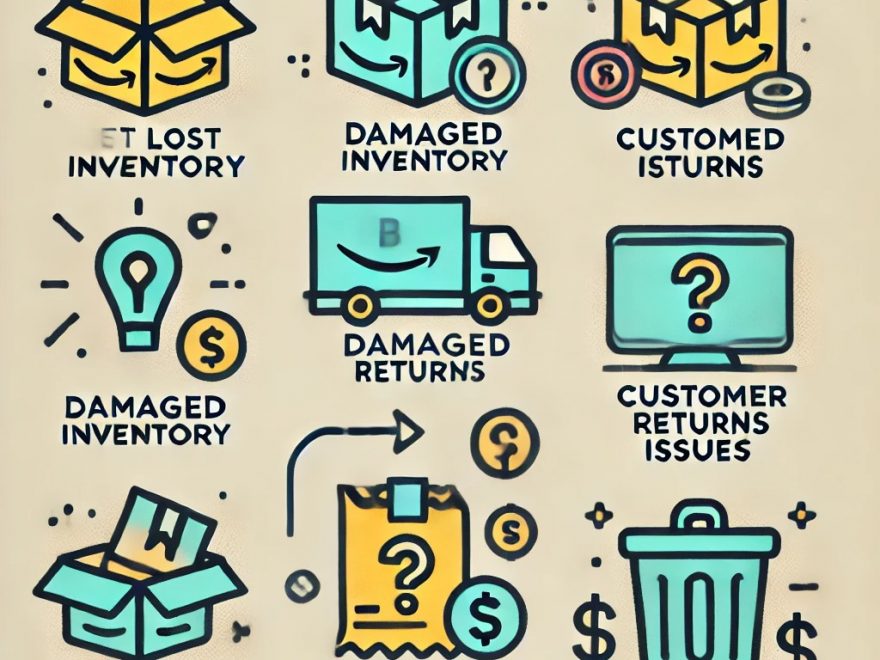Selling on Amazon through Fulfillment by Amazon (FBA) has many advantages, but it also comes with potential financial losses. Amazon handles millions of products daily, and mistakes are inevitable. Items go missing, get damaged, or are miscounted. When this happens, Amazon may owe you money—but they don’t always reimburse sellers automatically.
To recover lost funds, you need to understand which issues qualify for an FBA reimbursement and how to file claims correctly. This guide breaks down the most common types of reimbursement cases, how much you can expect to recover, and how an Amazon reimbursement service like Refunzo can help.
What qualifies for an Amazon FBA reimbursement?
Amazon has specific rules about when they will reimburse sellers. Generally, an issue must be Amazon’s fault for it to qualify. Here are the most common cases where sellers can request a refund:
- Lost inventory
Amazon tracks every unit you send to their warehouses, but inventory often goes missing due to human error, misplacement, or system glitches. You may be eligible for reimbursement if:
- Your shipped inventory never appears in Amazon’s system.
- Items go missing inside fulfillment centers and are never located.
- Amazon misplaces inventory when transferring stock between warehouses.
- Damaged inventory
If Amazon damages your inventory while handling it, they should compensate you. This includes:
- Items damaged in Amazon’s warehouse before being sold.
- Products broken during fulfillment or shipping by Amazon.
- Stock damaged during inter-warehouse transfers.
If Amazon damages a product and fails to reimburse you automatically, you have to file a claim to recover your money.
- Customer return issues
Customer returns are one of the biggest sources of FBA reimbursement claims. Amazon has strict return policies, but they don’t always process returns correctly. You can request reimbursement if:
- A customer gets a refund but never returns the item.
- The returned item is unsellable, but Amazon doesn’t refund you.
- The return is past Amazon’s allowed return window, but they still deduct money from your account.
- Miscalculated fees
Amazon charges storage fees, weight-based fees, and referral fees, but they sometimes make mistakes. If Amazon overcharges you, you can file for reimbursement. Common fee errors include:
- Incorrect weight or size calculations, leading to higher fees.
- Overcharged storage fees based on inaccurate dimensions.
- Referral fee errors where Amazon takes more than they should.
- Miscounted inventory
Amazon’s system doesn’t always track inventory accurately. Common errors include:
- Incorrect inventory adjustments, where stock is deducted but never added back.
- Unprocessed removals, where items are marked for return to you but never arrive.
- Duplicate deductions, where the same product is removed multiple times.
- Warehouse transfer mistakes
Amazon frequently moves inventory between fulfillment centers. Sometimes, these transfers result in:
- Stock going missing before it reaches the new location.
- Inventory showing as shipped but never received in the new warehouse.
- Incorrect tracking updates, making it seem like your products were never in stock.
- Destroyed inventory without permission
If Amazon decides that an item is unsellable, they might destroy it without your approval. If this happens, you should receive a reimbursement—but Amazon doesn’t always issue refunds unless you file a claim.
How much money can you recover through reimbursements?
The amount you can recover depends on several factors, including:
How long you’ve been selling on Amazon.
- The total number of transactions your account processes.
- The frequency of Amazon fulfillment errors in your account.
Many sellers recover 1-3% of their total revenue through reimbursements. If you sell $100,000 annually, you could be missing out on $1,000 to $3,000 in unclaimed refunds.
However, manually checking for missing reimbursements can take hours each month. That’s why many sellers rely on an FBA reimbursement agency like Refunzo to handle the process.
How to file an FBA reimbursement claim
If you want to recover your money, you have two options:
- Manually file claims in Seller Central
If you prefer to handle reimbursements yourself, follow these steps:
- Log into Seller Central and open the “Inventory Adjustments” report.
- Check for missing or damaged inventory that hasn’t been reimbursed.
- Open a support case with Amazon and provide evidence of the issue.
- Follow up with Amazon if they don’t respond within a few days.
While this method works, it requires constant monitoring and detailed record-keeping.
- Automate the process with Refunzo
If you don’t have time to track reimbursements manually, a trusted Amazon reimbursement service like Refunzo can handle everything for you. Here’s how it works:
- Connect your Amazon account securely to Refunzo.
- Run an automated scan to detect lost, damaged, or miscalculated items.
- Receive a detailed report showing how much Amazon owes you.
- Let Refunzo file the claims for you, ensuring maximum reimbursements.
Why choose Refunzo?
Many sellers struggle with the reimbursement process because Amazon’s system is complex. Refunzo makes it easy by automating the entire process. Key benefits include:
- Saves time – No need to manually search for errors in Amazon’s reports.
- Maximizes your refunds – Identifies every eligible reimbursement case.
- No upfront costs – You only pay when Refunzo successfully recovers your money.
- 100% Amazon-compliant – Ensures claims follow Amazon’s rules.
Don’t let Amazon keep your money
If you’re an FBA seller, there’s a good chance Amazon owes you money. Many sellers recover thousands of dollars in lost inventory, damaged stock, and overcharged fees—but only if they check their accounts and file claims.
Manually tracking these errors is difficult, but an FBA reimbursement agency like Refunzo can ensure you never miss a refund again.
Start your free account today and see how much money Amazon owes you!



